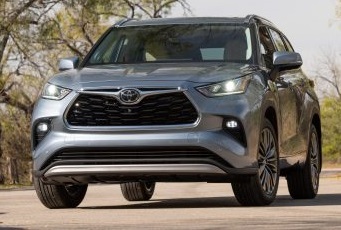
The 2020 Toyota Highlander Platinum in the new paint color of Moon Dust. (All photos courtesy of Toyota)
BY MARK MAYNARD
The fourth-generation 2020 Toyota Highlander is a revitalized expression of family care, wrapped in an armor of advanced safety systems. The redesigned midsize SUV — now built on the Toyota New Global Architecture — represents hundreds of thousands of Highlanders that have been sold since its 2001 debut in the U.S.
It is currently Toyota’s second-best-selling SUV. It follows the compact-class RAV4 but is ahead of the 4Runner, subcompact C-HR, Sequoia and Land Cruiser.
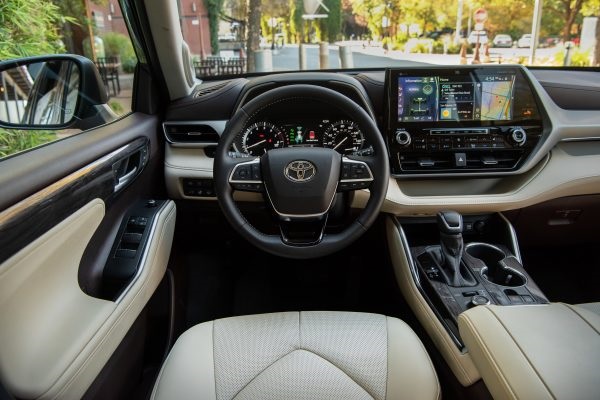
Exterior design
Much care went into redesigning the 2020 Toyota Highlander. It is an all-new construction, except for the carryover V-6 engine. The “bold and chiseled” design language is evolutionary but with substantial presence. It is defined by an aggressive face, boomerang angles and character bulges.
The new model is about the same size as before but 2.36 inches longer. The length went to the cargo area, which was requested by owners. The expanded capacity is also more competitive with other three-row SUV crossovers, such as the Kia Telluride. The second row now slides an extra 1.2 inches farther to give more legroom to the third row or to stretch cargo space.
But the Highlander’s more premium presentation inside will be most appreciated to the loyalists.
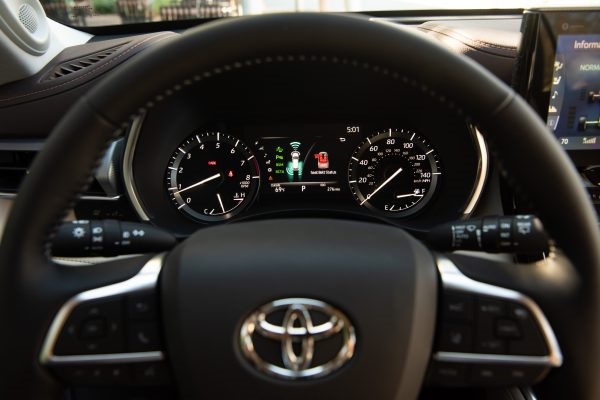
Pricing
Highlander is again available in gasoline or gasoline-electric hybrid models in front or all-wheel drive. Three rows of seating can be configured for seven or eight. Second-row captain’s chairs or a three-position bench are no-cost options.
Sold in five trim levels, including the new base L, starting prices range from $35,720 with front-drive to $49,920 AWD. Pricing includes the $1,120 freight charge from Princeton, Ind.
The Toyota Highlander Hybrid is just $1,400 more than the gas version (depending on the model). The Hybrid is sold in four trim levels of front- or AWD with starting prices of $39,745-$51,745.
All trim levels are socially connected with Apple CarPlay, Android Auto, Amazon’s Alexa, Waze (driving directions), satellite radio and a Wi-Fi hot spot.
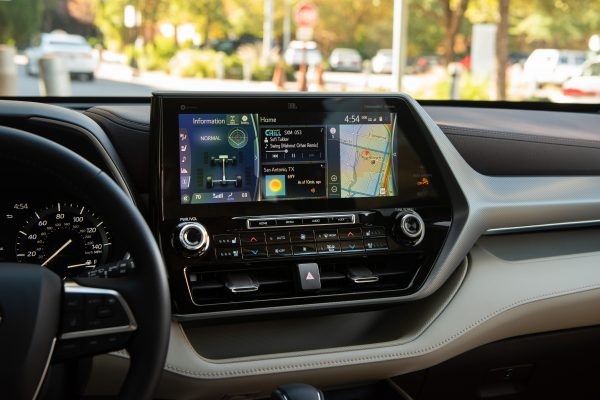
The Highlander Platinum’s 12.3-inch-wide infotainment screen is easy to read in all lighting conditions.
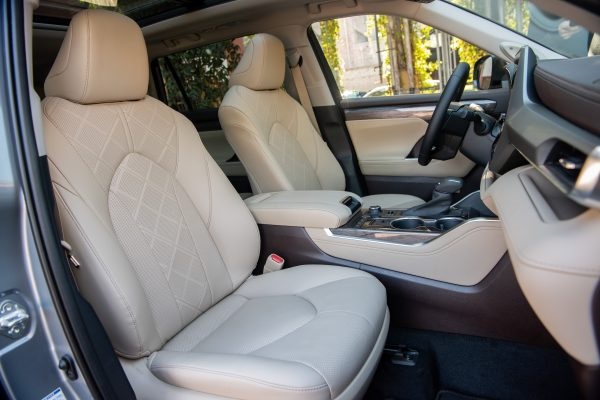
This is a big cabin with elbow and shoulder room.
Today’s tester is a Platinum AWD with second-row captain’s chairs that was $51,112 with three options: the new Moon Dust (ice blue) metallic paint ($415), carpeted floor mats and cargo mat ($318) and roof rack crossbars ($350) and universal table holder ($99).
Powertrains
Gasoline Highlanders use a 295-horsepower 3.5-liter V-6 with eight-speed automatic transmission.
The hybrid model is powered by a 2.5-liter direct-injection Atkinson-cycle four-cylinder. It has a total power rating of 243-hp combined with the electric motors and engine. Peak torque is 175 foot-pounds at 4,400 rpm.
The Platinum will be the empty-nesters’ escape with its elevated luxury treatment in presence and technologies. It is a best-of collection with the new 12.3-inch touch-screen infotainment display (8-inches on the other models), a 1,200-watt, 11-speaker JBL sound system and laminated front side window glass for soundproofing. The leather upholstery, perforated and neatly stitched, appears to be sourced from Lexus (Toyota’s luxury brand).
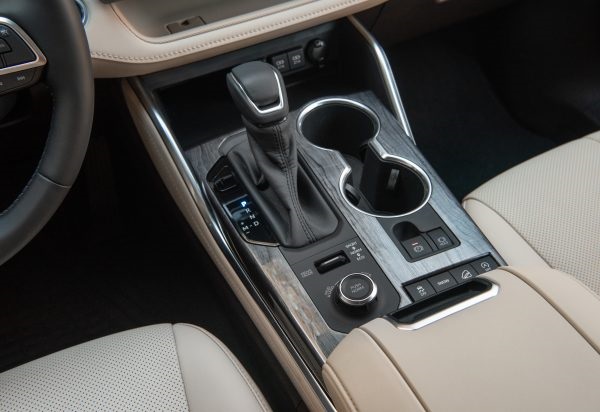
The shifter console packages an e-bin with two 2.1-amp charging USBs and there’s a tray above to lay a phone, with a small cutout (seen below) to route a charging cable.
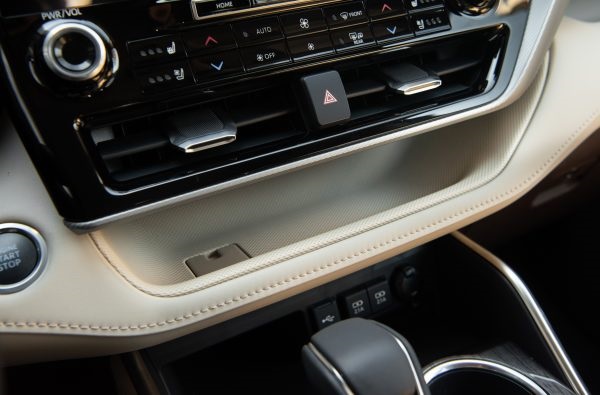
While $51,000 is not unreasonable for what Toyota delivers, the midrange XLE is $10K less. With one package for premium audio, $1,400 and carpeted floor mats, the MSRP would be $42,078 and the hybrid equivalent would be $45,078.
Find lease or purchase price incentives here.

2021 XSE model
And later this year Toyota will debut the sportier XSE. It injects some life into the drive with higher-rate springs and a rear stabilizer bar, and the shock absorbers and electric power steering have been tuned for quicker response.

The front fascia, grille and lower spoiler are exclusive to the XSE to give it a more aggressive stance. The headlamps have black accents and light-strip DRLs. And inside, are black Softex (synthetic leather) seats with fabric inserts, but a two-tone red and black leather-trimmed interior with red-stitched instrument panel is optional.

Safety features
All models now include Toyota Safety Sense 2.0 system with:
•Pre-collision system with pedestrian detection;
•Full-speed-range dynamic radar cruise control;
•Lane-departure alert with steering assist;
•Automatic high beam control;
•Lane-tracing assist;
•Road sign assist and cyclist detection.
Other standard safety features include eight air bags, blind-spot monitor with rear cross-traffic alert, hill-start assist and downhill assist.

The 295-hp 3.5-liter V-6 has AWD fuel-mileage ratings of 20/27/23 mpg on the recommended 87 octane fuel.
Performance
I appreciated the V-6 in the 4,450-pound Platinum, but its peak pulling power (torque) of 263 foot-pounds is high in the power band at 4,700 rpm. Its force will be out of reach to most drivers on the daily commute. The eight-speed automatic is dutiful in performance, but Sport mode sharpens the response time. The power is measured but it’s there when needed.
Fuel economy is the bigger benefactor. The AWD model has mileage ratings of 20/27/23 mpg or just a tick better with front-drive at 21/29/24, on the recommended 87 octane. My best was 23.4 mpg combined city/highway.
The hybrid has impressive mileage ratings of 36/35/36 mpg for front-drive or 35/35/35 mpg with AWD. The range dips to 35/34/35 for the heavier Limited and Platinum models, also on 87 octane. I have not tested the hybrid, but performance through the eCVT (continuously variable) transmission should have the benefit of more immediate thrust from the electric motor.

20-inch Bridgestone Alenza all-season tires.
Ride and handling
The Highlander drives more as a car than an SUV crossover. Its comfortable step-in height has no obstruction from sporty seat bolsters. Driver sightlines are unobstructed and the turning circle is a parking savior at 37.4 feet, the same as the base-model Camry.
Power-assisted four-wheel discs brakes are ready for towing with 13.3-inch vented rotors front and solid 13.3-inch rotors rear.

It is a comfortable ride, tuned for mainstream-America comfort, capably blunting the impact of potholes and busted pavement. When pushed hard, it responds as a big, comfy sedan.
The enhanced soundproofing (with the Platinum’s laminated front and side glass) creates a quiet cabin. The 20-inch Bridgestone Alenza all-season tires have a tall sidewall for a cushioned ride quality and protection from curb rash to the wheels when parking. The Alenza’s were quieter on the highway than I anticipated for a somewhat hard tire with a 65,000-mile warranty and a 500 treadwear rating.
Driver-assist system
Dynamic radar cruise control with driver-assist steering and braking technologies does a good job of centering the vehicle in the lane. But it let the Highlander drift over the white lines or Botts dots and then gave me a warning for the transgression.
These systems seem to be easily confused with varying light and road-surface conditions. Always use these driver-assist systems with both hands on the wheel.
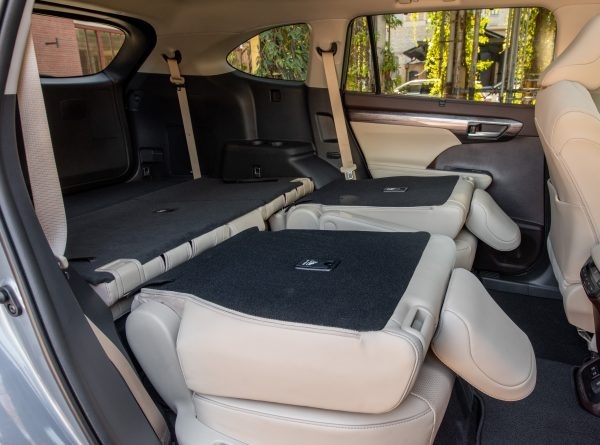
Fold both rows for up to 7 feet of length.
Interior
This is a big cabin with elbow and shoulder room. There is plenty of space to ergonomically place screens, switches and areas for small-item storage.
The driver area is smartly arranged for multitasking. The Platinum’s 12.3-inch-wide infotainment screen is a billboard of information but not prone to glare. The big screen has two to three panels for such information as car settings, music or navigation. And there are knobs for audio volume and tuning. There also is a tier of switches for temperature, fan speed, vents and seat heaters.
The shift console packages an e-bin with two 2.1-amp charging USBs. A tray above in the dashboard face is wide enough to lay a phone and the tray includes a small cutout to route a charging cable. For newer phones, the wireless charging pad is in the center armrest console. The three-level armrest box is deep with a removable second-level tray.
2nd- and 3rd-row features
The back seat in the Highlander has a flat floor with a center floor console with cup holders. It integrates controls for temperature, fan speed and seat heaters. There also are two 2.1-amp USBs and a 12-volt household plug, but it is light duty at 100 watts.
The raised second-row benefits from manual sunshades. The chairs will tip and slide for third-row access or the seatbacks will fold flat for cargo.
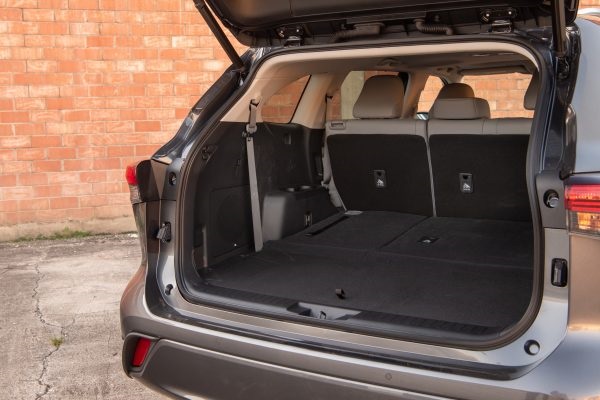
The waaay back three-seat bench is best for children. Legroom is tight at 27.7 inches. There are dual cup holders, but no ports or plugs for device charging. The 60/40 split seatbacks (with three head restraints) have several inches of recline.
Cargo capacity
The longer body translates to 2.36 cubic feet more space behind the third row, now at 16 cu. ft. Fold the third row for 48.4 cu. ft. of flat and square space that is 3 ½-feet deep. Drop both rows for up to 7 feet of length.
Why buy the Toyota Highlander
There are at least 10 other three-row SUV crossovers in the segment this year. Toyota was careful to craft its new Highlander for quality and nimble stability.
Some SUVs will feel stiff and clumsy in the name of “sporty,” but the Highlander is built for comfort and long-term ownership.

The fourth-generation Toyota Highlander is 2.36 inches longer, all in the cargo area.
2020 Toyota Highlander Platinum
Body style: Midsize, 7-8 seat, three-row SUV crossover with front- or all-wheel drive
Engine: 295-hp, direct-injection 3.5-liter V-6 with auto stop-start at idle; 263 lb.-ft. torque at 4,700 rpm
Transmission: 8-speed automatic; w/electronic on-demand AWD
Fuel economy: 21/29/24 mpg city/hwy/combined; 87 octane or higher
Tow capacity: 5,000 lbs.
SPECIFICATIONS
Fuel tank: 17.9 gal.
Cargo space: 16-48.4 cu. ft.
Front head/leg room: 38.4*/ in. *39.9 w/o moonroof
2nd-row head/leg room: 39.4/41 in.
3rd-row head/leg room: 36.1/27.7 in.
Length/wheelbase: 194.9/112.2 in.
Curb weight: 4,450 lbs.
Turning circle: 37.4 ft.
FEATURES
Standard Platinum equipment includes: smart-key entry with push-button ignition, bird’s-eye view camera with guidance lines and overhead 360-degree view, leather-trimmed upholstery in front- and second-row seats, 11-speaker JBL Clari-Fi premium audio system with driver easy speak microphone, heated and ventilated front seats, heated steering wheel, 10-way power-adjustable driver’s seat with power lumbar, panoramic view moonroof with sunshade, wireless phone charging, hands-free power liftgate, electric parking brake, heated side mirrors with turn signal and blind-spot indicators and Highlander-logo puddle lights, 2nd-row fold-down captain’s chairs with armrests, 60/40 folding and reclining 3rd-row seats, back-up camera washer, 20-inch alloy wheels with 235/55 all-season tires, heated 2nd row seats with sunshades, cargo area tonneau cover
Driver-assist features
Front and rear parking assist with automatic braking, 12.3-inch touch screen, dynamic navigation and media port, digital rearview mirror, 10-inch color head-up display with speedometer and road sign assist and navigation, auto-leveling and turning LED headlights, LED running lights and taillights and LED fog lights
Safety features include: 8 air bags, precollision system with pedestrian detection, lane departure alert with steering assist, lane tracing assist, automatic high beams, full-speed-range dynamic radar cruise control, road sign assist and cyclist detection, blind-spot monitor with rear cross-traffic alert, hill-start assist and downhill assist
PRICING
Base price: $49,920, including $1,120 freight charge; price as tested $51,112
Options on test vehicle: Moon Dust paint $425; carpeted floor mats and cargo mat $318; cargo roof-rack cross bars $350; and universal tablet holder $99
Where assembled: Princeton, Ind.
Warranty: 3-years/36,000-miles bumper to bumper with free scheduled maintenance for 2-years/25,000-miles; 5-years/60,000-miles powertrain

